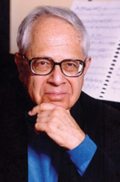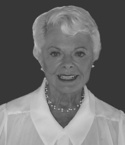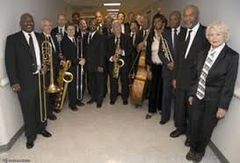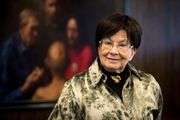Difference between revisions of "Golden Oldies"
| Line 5: | Line 5: | ||
==Andrew Frierson== | ==Andrew Frierson== | ||
| − | The <b>bass-baritone</b> Andrew Frierson was was an opera singer of African-American heritage. Born on March 29,1924, in Columbia, South Carolina, he spent his later decades in Oberlin, OH, where he died on December 6, 2018. After giving a debut recital in Carnegie Hall (1948), he sang with the New York City Opera for six seasons, then taught at Southern University (Baton Rouge, LA), the Henry Street Settlement Music School (New York), and Oberlin Conservatory of Music. | + | The <b>bass-baritone</b> Andrew Frierson was was an opera singer of African-American heritage. Born on March 29,1924, in Columbia, South Carolina, he spent his later decades in Oberlin, OH, where he died on December 6, 2018. After giving a debut recital in Carnegie Hall (1948), he sang with the New York City Opera for six seasons, then taught at Southern University (Baton Rouge, LA), the Henry Street Settlement Music School (New York), and the Oberlin Conservatory of Music. |
Frierson took an interest in the piano from the age of three, when he started teaching himself to play. His college studies (Fisk University, Nashville, TN) were interrupted by the Second World War, during which he served in the South Pacific. He took up singing on his return and was accepted at the Juilliard School (New York) a few years later. There he became friends with two other voice students, Leontyne Price and Billie Lynn Daniel, who became his wife (1953). While still a student, Frierson won praise in the New York Times for "a beautiful voice, good technique, musicianship, sympathy, and a fine presence." He continued his studies at the Manhattan School of Music. | Frierson took an interest in the piano from the age of three, when he started teaching himself to play. His college studies (Fisk University, Nashville, TN) were interrupted by the Second World War, during which he served in the South Pacific. He took up singing on his return and was accepted at the Juilliard School (New York) a few years later. There he became friends with two other voice students, Leontyne Price and Billie Lynn Daniel, who became his wife (1953). While still a student, Frierson won praise in the New York Times for "a beautiful voice, good technique, musicianship, sympathy, and a fine presence." He continued his studies at the Manhattan School of Music. | ||
| − | His appearances covered a broad terrain, ranging from his performance at the March on Washington for Jobs and Freedom (1963), where the Rev. Dr. Martin Luther King gave his "I Have a Dream" speech. He appeared with the Harry Belafonte Folk singers. In the New York City Opera he portrayed such figures as [https://en.wikipedia.org/wiki/Porgy_and_Bess Porgy] in Gershwin's noted opera, the King of Egypt in Verdi's [https://en.wikipedia.org/wiki/Aida <i>Aida</i>], and Caronte (Monteverdi's [https://en.wikipedia.org/wiki/L%27Orfeo <i>Orfeo</i>]). He retired from private teaching shortly before his 90th birthday. His grandson, Adam Frierson Goins, is a conductor, singer, and producer. | + | His appearances covered a broad terrain, ranging from his performance at the [https://en.wikipedia.org/wiki/March_on_Washington_for_Jobs_and_Freedom March on Washington for Jobs and Freedom (1963)], where the Rev. Dr. Martin Luther King gave his "I Have a Dream" speech. He appeared with the Harry Belafonte Folk singers. In the New York City Opera he portrayed such figures as [https://en.wikipedia.org/wiki/Porgy_and_Bess Porgy] in Gershwin's noted opera, the King of Egypt in Verdi's [https://en.wikipedia.org/wiki/Aida <i>Aida</i>], and Caronte (Monteverdi's [https://en.wikipedia.org/wiki/L%27Orfeo <i>Orfeo</i>]). He retired from private teaching shortly before his 90th birthday. His grandson, Adam Frierson Goins, is a conductor, singer, and producer. |
==Gary Graffman== | ==Gary Graffman== | ||
Revision as of 23:45, 21 February 2019
Golden Oldies is a collection of studies of musicians who continue to performing in public at the age of 90 and beyond. Its underlying goal is to identify cognitive and physical factors that contribute to the preservation of musical memory. This resource on noted figures will be complemented by a second one listing musicians described anonymously.
Contents
Professional musicians (named) performing publicly
Andrew Frierson
The bass-baritone Andrew Frierson was was an opera singer of African-American heritage. Born on March 29,1924, in Columbia, South Carolina, he spent his later decades in Oberlin, OH, where he died on December 6, 2018. After giving a debut recital in Carnegie Hall (1948), he sang with the New York City Opera for six seasons, then taught at Southern University (Baton Rouge, LA), the Henry Street Settlement Music School (New York), and the Oberlin Conservatory of Music.
Frierson took an interest in the piano from the age of three, when he started teaching himself to play. His college studies (Fisk University, Nashville, TN) were interrupted by the Second World War, during which he served in the South Pacific. He took up singing on his return and was accepted at the Juilliard School (New York) a few years later. There he became friends with two other voice students, Leontyne Price and Billie Lynn Daniel, who became his wife (1953). While still a student, Frierson won praise in the New York Times for "a beautiful voice, good technique, musicianship, sympathy, and a fine presence." He continued his studies at the Manhattan School of Music.
His appearances covered a broad terrain, ranging from his performance at the March on Washington for Jobs and Freedom (1963), where the Rev. Dr. Martin Luther King gave his "I Have a Dream" speech. He appeared with the Harry Belafonte Folk singers. In the New York City Opera he portrayed such figures as Porgy in Gershwin's noted opera, the King of Egypt in Verdi's Aida, and Caronte (Monteverdi's Orfeo). He retired from private teaching shortly before his 90th birthday. His grandson, Adam Frierson Goins, is a conductor, singer, and producer.
Gary Graffman
Gary Graffman's tenure as director of the Curtis Institute in Philadelphia (1986-2006) began a half-century after he was accepted (at age 7) as a classical piano student. Born in New York City to Russian emigré parents on 14 October 1928,Graffman received his first musical instruction from his father, a violinist. At Curtis he studied with Isabelle Vengerova (who was in turn a pupil of Leschetizky) and later with Vladimir Horozitz} (1903-1989) and [https://en.wikipedia.org/wiki/Rudolf_Serkin Rudolf Serkin (1903-1991).
Graffman made his piano debut in 1936 with the Philadelphia Symphony Orchestra. His international career was established two years later, when he won the Leventritt Award. His performances were captured on countless recordings by CBS and RCA. He appeared with numerous celebrated orchestras and conductors. His flourishing career was modified during the civil rights movement of the 1960s, when Graffman became one of the first professional musicians to boycott segregated concert halls in the southern US. Many colleagues followed his example.
His career changed direction in 1979, when he developed focal dystonia, a neurological problem associated in musicians with repetitive physical stress. He cut back on his performance schedule and took a teaching position at Curtis. His new specialization in works for the left hand alone prompted the composition of several news works. Notable among them were Ned Rorem's Piano Concerto No. 4 (Philadelphia Academy of Music, 1993) and, with Leon Fleischer, William Bolcom's Concerto for Two Left Hands (1996).
Graffman's Curtis students have included Lang Lang and Yuja Wang. In 1986 he was named director of the Institute, a post he held until 2006. He continues to teach at Curtis.
Dionisio Lind
The carillonneur Dionisio Lind (10 February 1931 - 10 October 2018) was captivated by the sound of the bells at St. Martin's Episcopal Church, Harlem (NY), in the 1950s. He took lessons there and began his official career as the church's carillonneur in 1960. He progressed so well that the church sent him to the Royal Carillon School in Mechelen, Belgium, in 1962. In 2000 he was invited to move to the Riverside Church, overlooking the Hudson River, at 120th St., where he served as principal carillonneur until his death.
The church, modeled on Chartres Cathedral, boasts a carillon with 74 bells ranging in weight from 10 pounds to 20 tons. (Its Bourdon is the heaviest in the world and uniquely reaches an octave lower than any other instrument of its kind.) To continue playing into his late 80s, Lind had to climb to the top of the 392-foot campanile each time he performed. He explains the bells and plays the carillon in this 2011 video interview by Allison Davis, published by the New York Daily News.
Roberta Mandel
Roberta Mandel (29 December 1920 - 5 September 2017) performed as a jazz pianist for 75 years. Trained as a classical pianist, she was also an arranger and composer. She had a special gift for transcribing by ear the arrangements she heard on recordings. She credited her extensive knowledge of harmony to her early studies of classical music (in which she earned two academic degrees from the California State University at San Francisco). Her arrangements of big-band numbers for solo piano were especially noted. Mandel was raised in San Francisco. Her first teacher was her mother, a pianist. In her travels as the leader of a traveling troupe of musicians that she met her future husband, William Mandel, in Illinois. Mandel had once been a radio Quiz Kid and was destined to became a noted tuberculosis researcher, writer, lecturer, and administrator. The Mandels made San Francisco their permanent home. Her parents' apartment, with its Steinway grand, served as a practice venue for Oscar Peterson, Art Tatum, and many other jazz greats when they visited San Francisco.
Mandel's longest engagement (32 years) was with the 18-member Junius Courtney Big Band, which was similarly noted for its arrangements. A frequent venue was the Freight & Salvage Coffeehouse in Berkeley. (Freight & Salvage, which offers open nights for jazz improvisation, celebrated its 50th anniversary in 2018.) Among her credits, Mandel was the first female pianist to sit in with the Count Basie Orchestra. Her 1982 transcription of Billy Strayhorn's "Blood Count" from the recording by Duke Ellington's Orchestra is preserved in the Smithsonian (National Museum of American History). Her book of compositions in leadsheet format, Jazz Tunes for Friends (1999-2004) is available from Sandscape Publications. This memoir from Jazz Now appeared in 1990.
Aldo Parisot
[[file:]]
The Brazilian cellist Aldo Parisot arrived in the US in 1946 to study at Yale University. After studies with xx and yy, he joined its music faculty on 1958, remaining in his post until a few months before his death on 29 December 2018. In this video he performs Bach's first cello suite on his 100th birthday (30 September 2018).
Parisot relates his own biography here.
Zuzana Ružičková
The world-renown harpichordist Zuzana Ružičhková (Pilsen, 14 January 1927 - Prague, 27 September 2017) was a noted interpreter of Bach. Her musical interest was evident from an early age. She seemed destined for a musical career after winning the ARD International Music Competition in Munich (1936). She declined a place on a Kindertransport (a rescue train for Jewish children) to Britain in 1939, but accompanied her parents (who ran a big toy store in Prague) to Terezin in 1942, where her father died. She and her mother were later moved to Auschwitz, where she was spared from the gas chamber twice--in the second case by the Allied invasion of occupied Poland. Together with her mother, she repaired oil pipelines in Hamburg before being shipped, months before the end of the war, to Bergen-Belsen.
She attended the Academy of Performing Arts in Prague from 1947 to 1951 and made more than 100 recordings. Her project to record all of Bach's music for harpsichord occupied her from 1995 to 2005. Although she stopped performing publicly after the death of her husband (the composer Viktor Kalabis) in 2006, she continued teaching. In a BBC interview in 2016 she reflected on her survival as a musician, saying "It is not enough to be an extraordinary musician....You have to have the feeling that you cannot live without music." This message will be elaborated in the forthcoming film Zuzana: Music is Life, which is being made under the auspices of the Viktor Kalabis-Zuzana Ružičková Foundation. Mahan Esfahani's reflection on her teaching is published in The New Yorker, October 21, 2017.
Professional musicians in music-centered retirement situations
The Casa Verdi (Milan)
In 1896, when he turned 65, Giuseppe Verdi established a home for retired professional musicians in a spacious period home on the Piazza Buonarroti in Milan. By 1899 it was ready to welcome its first cohort of retirees. The Casa Verdi has numerous practice rooms, concert facilities, and musical instruments. Those who live there enjoy the company of other retired musicians and form their own groups. In recent years the Casa has also rented rooms to music students, who entertainment the residents and sometimes performed with them.
The Casa Verdi is depicted in Daniel Schmid's film Il bacio di Tosca (Tosca's Kiss) (1984). Ronald Harwood's play (1999), turned into an award-winning film by Dustin Hoffman's award-winning film Quartet (2012), was modeled on the Casa Verdi transposed to rural England.




